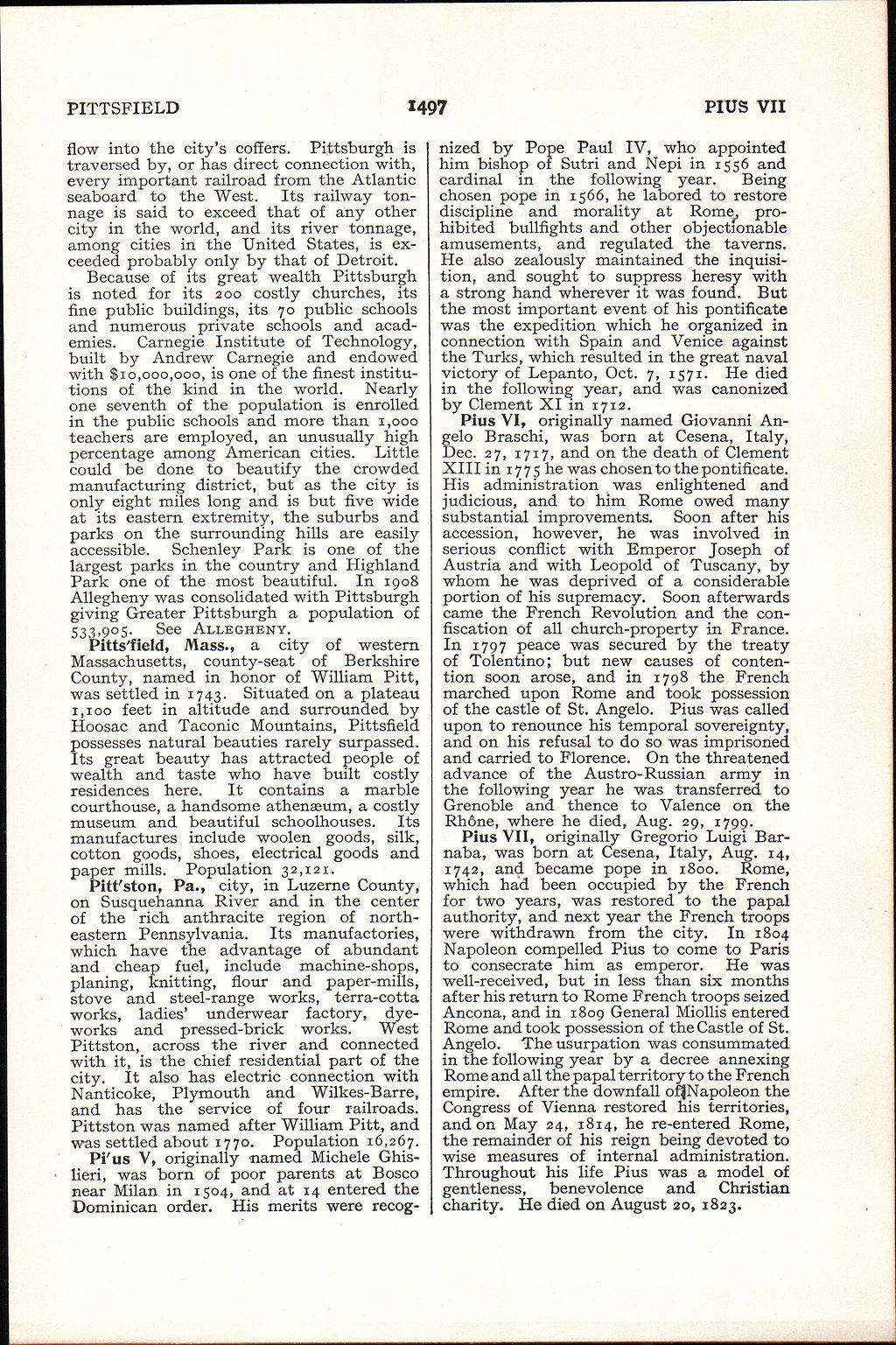flow into the city's coffers. Pittsburgh is traversed by, or has direct connection with, every important railroad from the Atlantic seaboard to the West. Its railway tonnage is said to exceed that of any other city in the world, and its river tonnage, among cities in the United States, is exceeded probably only by that of Detroit.
Because of its great wealth Pittsburgh is noted for its 200 costly churches, its fine public buildings, its 70 public schools and numerous private schools and academies. Carnegie Institute of Technology, built by Andrew Carnegie and endowed with $10,000,000, is one of the finest institutions of the kind in the world. Nearly one seventh of the population is enrolled in the public schools and more than 1,000 teachers are employed, an unusually high percentage among American cities. Little could be done to beautify the crowded manufacturing district, but as the city is only eight miles long and is but five wide at its eastern extremity, the suburbs and parks on the surrounding hills are easily accessible. Schenley Park is one of the largest parks in the country and Highland Park one of the most beautiful. In 1908 Allegheny was consolidated with Pittsburgh giving Greater Pittsburgh a population of 533,905. See Allegheny.
Pitts′field, Mass., a city of western Massachusetts, county-seat of Berkshire County, named in honor of William Pitt, was settled in 1743. Situated on a plateau 1,100 feet in altitude and surrounded by Hoosac and Taconic Mountains, Pittsfield possesses natural beauties rarely surpassed. Its great beauty has attracted people of wealth and taste who have built costly residences here. It contains a marble courthouse, a handsome athenæum, a costly museum and beautiful schoolhouses. Its manufactures include woolen goods, silk, cotton goods, shoes, electrical goods and paper mills. Population 32,121.
Pitt′ston, Pa., city, in Luzerne County, on Susquehanna River and in the center of the rich anthracite region of northeastern Pennsylvania. Its manufactories, which have the advantage of abundant and cheap fuel, include machine-shops, planing, knitting, flour and paper-mills, stove and steel-range works, terra-cotta works, ladies' underwear factory, dye-works and pressed-brick works. West Pittston, across the river and connected with it, is the chief residential part of the city. It also has electric connection with Nanticoke, Plymouth and Wilkes-Barre, and has the service of four railroads. Pittston was named after William Pitt, and was settled about 1770. Population 16,267.
Pi′us V, originally named Michele Ghislieri, was born of poor parents at Bosco near Milan in 1504, and at 14 entered the Dominican order. His merits were recognized by Pope Paul IV, who appointed him bishop of Sutri and Nepi in 1556 and cardinal in the following year. Being chosen pope in 1566, he labored to restore discipline and morality at Rome, prohibited bullfights and other objectionable amusements, and regulated the taverns. He also zealously maintained the inquisition, and sought to suppress heresy with a strong hand wherever it was found. But the most important event of his pontificate was the expedition which he organized in connection with Spain and Venice against the Turks, which resulted in the great naval victory of Lepanto, Oct. 7, 1571. He died in the following year, and was canonized by Clement XI in 1712.
Pius VI, originally named Giovanni Angelo Braschi, was born at Cesena, Italy, Dec. 27, 1717, and on the death of Clement XIII in 1775 he was chosen to the pontificate. His administration was enlightened and judicious, and to him Rome owed many substantial improvements. Soon after his accession, however, he was involved in serious conflict with Emperor Joseph of Austria and with Leopold of Tuscany, by whom he was deprived of a considerable portion of his supremacy. Soon afterwards came the French Revolution and the confiscation of all church-property in France. In 1797 peace was secured by the treaty of Tolentino; but new causes of contention soon arose, and in 1798 the French marched upon Rome and took possession of the castle of St. Angelo. Pius was called upon to renounce his temporal sovereignty, and on his refusal to do so was imprisoned and carried to Florence. On the threatened advance of the Austro-Russian army in the following year he was transferred to Grenoble and thence to Valence on the Rhône, where he died, Aug. 29, 1799.
Pius VII, originally Gregorio Luigi Barnaba, was born at Cesena, Italy, Aug. 14, 1742, and became pope in 1800. Rome, which had been occupied by the French for two years, was restored to the papal authority, and next year the French troops were withdrawn from the city. In 1804 Napoleon compelled Pius to come to Paris to consecrate him as emperor. He was well-received, but in less than six months after his return to Rome French troops seized Ancona, and in 1809 General Miollis entered Rome and took possession of the Castle of St. Angelo. The usurpation was consummated in the following year by a decree annexing Rome and all the papal territory to the French empire. After the downfall of Napoleon the Congress of Vienna restored his territories, and on May 24, 1814, he re-entered Rome, the remainder of his reign being devoted to wise measures of internal administration. Throughout his life Pius was a model of gentleness, benevolence and Christian charity. He died on August 20, 1823.
